Study on Soil Water Infiltration Process and Model Applicability of Check Dams
Abstract
:1. Introduction
2. Materials and Methods
2.1. Overview of the Study Area
2.2. Experimental Design and Sampling
- (1)
- Bright blue dyeing experiment
- (2)
- Double-ring infiltration experiment
2.3. Infiltration Model
2.4. Sample Collection
2.5. Data Calculation and Processing
3. Results
3.1. Dam Soil Infiltration Mode
3.2. Infiltration Characteristics of Dam Soil
3.3. Water-Blocking Capacity of Silted Dense Layer
3.4. Influencing Factors of Soil Infiltration Characteristics in the Dam Site
3.5. Simulation of Soil Water Infiltration Process in Dam Land
4. Discussion
4.1. Analysis on Infiltration Mode and Process of Dam Soil
4.2. Analysis of the Water-Blocking Capacity of Silted Dense Layer
4.3. Analysis of the Influencing Factors of Soil Infiltration Characteristics in the Dam Site
4.4. Applicability Analysis of Infiltration Model
5. Conclusions
- (1)
- The number of macropores in the soil of the check dam is small, and the water mainly moves downward in the form of matrix flow, without preferential flow. Its infiltration process is similar to the normal, divided into three stages: rapid infiltration, fluctuating infiltration, and stable infiltration.
- (2)
- The silted dense layer can store water and hinder the downward movement of water. In the same profile, the soil water content in the silted dense layer is higher than that in the non-silted dense layer, and the infiltration rate is significantly lower than that in the non-silted dense layer. The maximum water content of the silted dense layer is 3.23 times that of the non-silted dense layer, and the infiltration rate of the non-silted dense layer is 2.4~5 times that of the silted dense layer.
- (3)
- The Horton model, Philip model, and Kostiakov model can be applied to simulate the water infiltration process of dam land. The Horton model outperforms the other two models’ in terms of accuracy and can provide a reference for the future simulation of dam land water infiltration.
Author Contributions
Funding
Institutional Review Board Statement
Informed Consent Statement
Data Availability Statement
Acknowledgments
Conflicts of Interest
References
- Zhang, Y.; Li, P.; Liu, X.J.; Xiao, L.; Shi, P.; Zhao, B.H. Effects of farmland conversion on the stoichiometry of carbon, nitrogen, and phosphorus in soil aggregates on the Loess Plateau of China. Geoderma 2019, 351, 188–196. [Google Scholar] [CrossRef]
- Wang, T.; Li, P.; Li, Z.B.; Hou, J.M.; Xiao, L.; Ren, Z.P.; Xu, G.C.; Yu, K.X.; Su, Y.Y. The effects of freeze–thaw process on soil water migration in dam and slope farmland on the Loess Plateau, China. Sci. Total Environ. 2019, 666, 721–730. [Google Scholar] [CrossRef] [PubMed]
- Wang, T.; Hou, J.M.; Li, P.; Zhao, J.H.; Li, Z.B.; Matta, E.; Ma, L.P.; Hinkelmann, R. Numerical simulation of check dams impacts on flood characteristics in a small catchment on the Loess Plateau, China. Nat. Hazards 2021, 105, 059–3077. [Google Scholar] [CrossRef]
- Bai, L.C.; Jiao, J.Y.; Wang, N.; Chen, Y.L. Structural Connectivity of Sediment Affected by Check Dams in Loess Hilly-Gully Region, China. Water 2021, 13, 2644. [Google Scholar] [CrossRef]
- Wang, Z.Y.; Chen, Z.Y.; Yu, S.; Zhang, Q.; Wang, Y.; Hao, J.W. Erosion-control mechanism of sediment check dams on the Loess Plateau. Int. J. Sediment Res. 2021, 36, 668–677. [Google Scholar] [CrossRef]
- Corradini, C. Soil moisture in the development of hydrological processes and its determination at different spatial scales. J. Hydrol. 2014, 516, 1–5. [Google Scholar] [CrossRef]
- Gwak, Y.; Kim, S. Factors affecting soil moisture spatial variability for a humid forest hillslope. Hydrol. Process. 2017, 31, 431–445. [Google Scholar] [CrossRef]
- Suo, L.Z.; Huang, M.B.; Zhang, Y.K.; Duan, L.X.; Shan, Y. Soil moisture dynamics and dominant controls at different spatial scales over semiarid and semi-humid areas. J. Hydrol. 2018, 562, 635–647. [Google Scholar] [CrossRef]
- Wang, S.; Fu, B.J.; Gao, G.Y.; Liu, Y.; Zhou, J. Responses of soil moisture in different land cover types to rainfall events in a re-vegetation catchment area of the Loess Plateau, China. Catena 2013, 101, 122–128. [Google Scholar] [CrossRef]
- Li, Z.S.; Yang, L.; Wang, G.L.; Hou, J.; Xin, Z.B.; Liu, G.H.; Fu, B.J. The management of soil and water conservation in the Loess Plateau of China: Present situations, problems, and counter-solutions. Acta Ecol. Sin. 2019, 39, 7398–7409. [Google Scholar]
- Wang, T.; Li, P.; Liu, Y.; Hou, J.M.; Li, Z.B.; Ren, Z.P.; Cheng, S.D.; Zhao, J.H.; Hinkelmann, R. Experimental investigation of freeze-thaw meltwater compound erosion and runoff energy consumption on loessal slopes. Catena 2020, 185, 104310. [Google Scholar] [CrossRef]
- Cheng, S.D.; Hang, P.L.; Li, P.; Cheng, Y.T.; Guo, M.J. Effects of terracing on the slope stability in the rocky mountain area of southern shaanxi province. Res. Soil Water Conserv. 2018, 25, 157–161, (In Chinese with English abstract). [Google Scholar]
- Chen, Y.P.; Wang, K.B.; Lin, Y.S.; Shi, W.Y.; Song, Y.; He, X.H. Balancing green and grain trade. Nat. Geosci. 2015, 10, 739–741. [Google Scholar] [CrossRef]
- Liang, W.; Bai, D.; Wang, F.Y.; Fu, B.J.; Yan, J.P.; Wang, S.; Yang, Y.T.; Long, D.; Feng, M.Q. Quantifying the impacts of climate change and ecological restoration on streamflow changes based on a Budyko hydrological model in China’s Loess Plateau. Water Resour. Res. 2015, 51, 6500–6519. [Google Scholar] [CrossRef]
- Liu, G.B.; Shanguan, Z.P.; Yao, W.Y.; Yang, Q.K.; Zhao, M.J.; Dang, X.H.; Guo, M.H.; Wang, G.L.; Wang, B. Ecological effects of soil conservation in Loess Plateau. Bull. Chin. Acad. Sci. 2017, 32, 11–19, (In Chinese with English abstract). [Google Scholar]
- Parimalarenganayaki, S.; Elango, L. Assessment of effect of recharge from a check dam as a method of Managed Aquifer Recharge by hydrogeological investigations. Environ. Earth Sci. 2015, 73, 5349–5361. [Google Scholar] [CrossRef]
- Ma, L.; Ni, Y.X.; Lv, X.Z.; Zhang, Q.F.; Liu, L.N. Study on relationship between underlying surface of typical warping dam and erosion and sediment yield. IOP Conf. Ser. Earth Environ. Sci. 2021, 687, 012060. [Google Scholar]
- Tang, H.L.; Ran, Q.H.; Gao, J.H. Physics-Based Simulation of Hydrologic Response and Sediment Transport in a Hilly-Gully Catchment with a Check Dam System on the Loess Plateau, China. Water 2019, 11, 1161. [Google Scholar] [CrossRef] [Green Version]
- Huang, X.; Shi, Z.H.; Zhu, H.D.; Zhang, H.Y.; Ai, L.; Yin, W. Soil moisture dynamics within soil profiles and associated environmental controls. Catena 2016, 136, 189–196. [Google Scholar] [CrossRef]
- Hu, G.J.; Tian, L.M.; Zhao, L.; Wu, X.D.; Li, R.; Wu, T.H.; Zhu, X.F.; Du, E.J.; Wang, Z.W.; Hao, J.M.; et al. Soil infiltration processes of different underlying surfaces in the permafrost region on the Tibetan Plateau. Hydrol. Sci. J. 2018, 63, 1733–1744. [Google Scholar] [CrossRef]
- Gao, X.D.; Wu, P.T.; Zhao, X.N.; Shi, Y.G.; Wang, J.W.; Zhang, B.Q. Soil moisture variability along transects over a well-developed gully in the Loess Plateau, China. Catena 2011, 87, 357–367. [Google Scholar] [CrossRef]
- Yuan, S.L.; Li, Z.B.; Chen, L.; Li, P.; Zhang, Z.Y.; Zhang, J.Z.; Wang, A.N.; Yu, K.X. Effects of a check dam system on the runoff generation and concentration processes of a catchment on the Loess Plateau. Int. Soil Water Conserv. Res. 2022, 10, 86–98. [Google Scholar] [CrossRef]
- Zhao, G.J.; Kondolf, G.M.; Mu, X.M.; Han, M.W.; Zhong, H.; Rubin, Z.; Wang, F.; Gao, P.; Sun, W.Y. Sediment yield reduction associated with land use changes and check dams in a catchment of the Loess Plateau, China. Catena 2017, 148, 126–137. [Google Scholar] [CrossRef]
- MMongil-Manso, J.; Díaz-Gutiérrez, V.; Navarro-Hevia, J.; Espina, M.; San Segundo, L. The role of check dams in retaining organic carbon and nutrients. A study case in the Sierra de vila mountain range (Central Spain). Sci. Total Environ. 2018, 657, 1030–1040. [Google Scholar] [CrossRef]
- Sheng, F.; Fang, Y. Study on preferential soil water flow using lodine-starch staining method. Soils 2012, 44, 144–148, (In Chinese with English abstract). [Google Scholar]
- Wang, J.K.; Guo, Y.F.; Qi, W.; Yao, Y.F.; Wang, H. Study on horizontal infiltration law and model test of pisha sandstone soil. J. Irrig. Drain. 2020, 39, 117–121, (In Chinese with English abstract). [Google Scholar]
- Li, H.Z.; Fan, G.S. A comparative analysis and study on forecast precision of parameters of kostiakov infiltration models. Water Sav. Irrig. 2017, 11, 27–30, (In Chinese with English abstract). [Google Scholar]
- Al Maimuri, N.M. Applicability of Horton model and recharge evaluation in irrigated arid Mesopotamian soils of Hashimiya, Iraq. Arab. J. Geosci. 2018, 11, 610. [Google Scholar] [CrossRef]
- Li, M.; Yang, E.; Li, P.; Bao, H.Z.; Kong, X.B.; Shen, Z.Z.; Wei, G.J. Study on the composition and changeable characteristic of sediment particle size in check dam system. J. Basic Sci. Eng. 2018, 26, 746–756, (In Chinese with English abstract). [Google Scholar]
- Zhang, Y.; Li, P.; Liu, X.J.; Xiao, L.; Li, Z.N.; Wu, H.; Zhou, S.X.; Ren, M.X. Tracer elements revealed the soil organic carbon sources in a dam-controlled watershed. Soil Tillage Res. 2022, 216, 105184. [Google Scholar] [CrossRef]
- Liu, Y.; Cui, Z.; Huang, Z.; López-Vicente, M.; Wu, G.L. Influence of soil moisture and plant roots on the soil infiltration capacity at different stages in arid grasslands of China-ScienceDirect. Catena 2019, 182, 104147. [Google Scholar] [CrossRef]
- Wu, G.L.; Liu, Y.; Yang, Z.; Cui, Z.; Deng, L.; Chang, X.F.; Shi, Z.H. Root channels to indicate the increase in soil matrix water infiltration capacity of arid reclaimed mine soils. J. Hydrol. 2017, 546, 133–139. [Google Scholar] [CrossRef]
- Zhao, G.; Klik, A.; Mu, X.; Wang, F.; Gao, P.; Sun, W. Sediment yield estimation in a small watershed on the northern Loess Plateau, China. Geomorphology 2015, 241, 343–352. [Google Scholar] [CrossRef]
- Cao, J.H.; Chen, P.P.; Gao, X.D.; Zou, Q.F.; Fang, Y.J.; Gu, X.B.; Zhao, X.N.; Li, Y.N. Effects of plastic film residue and emitter flow rate on soil water infiltration and redistribution under different initial moisture content and dry bulk density. Sci. Total Environ. 2021, 807, 151381. [Google Scholar]
- Shi, P.; Li, P.; Li, Z.; Sun, J.; Wang, D.; Min, Z. Effects of grass vegetation coverage and position on runoff and sediment yields on the slope of Loess Plateau, China. Agric. Water Manag. 2022, 259, 107231. [Google Scholar] [CrossRef]
- Wang, X.Y.; Liao, W.H.; Song, P.B.; Zhang, Y.B.; Lei, X.H.; Wu, D.D. Research on the Field-scale soil infiltration law and spatial variability. China Rural Water Hydropower 2020, 448, 105–109, (In Chinese with English abstract). [Google Scholar]
- Jaiswal, P.; Gao, Y.F.; Rahmati, M.; Vanderborght, J.; Simunek, J.; Vereecken, H.; Vrugt, J.A. Parasite inversion for determining the coefficients and time-validity of Philip’s two-term infiltration equation. Vadose Zone J. 2022, 21, e20166. [Google Scholar] [CrossRef]
- Selker, J.S.; Duan, J.; Parlange, J.Y. Green and Ampt infiltration into soils of variable pore size with depth. Water Resour. Res. 1999, 35, 1685–1688. [Google Scholar] [CrossRef] [Green Version]
- Xie, C.K.; Cai, S.Z.; Yu, B.Q.; Yan, L.B.; Liang, A.Z.; Che, S.Q. The effects of tree root density on water infiltration in urban soil based on a Ground Penetrating Radar in Shanghai, China. Urban For. Urban Green. 2020, 50, 126648. [Google Scholar] [CrossRef]
- Khasraei, A.; Abyaneh, H.Z.; Jovzi, M.; Albaji, M. Determining the accuracy of different water infiltration models in lands under wheat and bean cultivation. J. Hydrol. 2021, 603, 127122. [Google Scholar] [CrossRef]
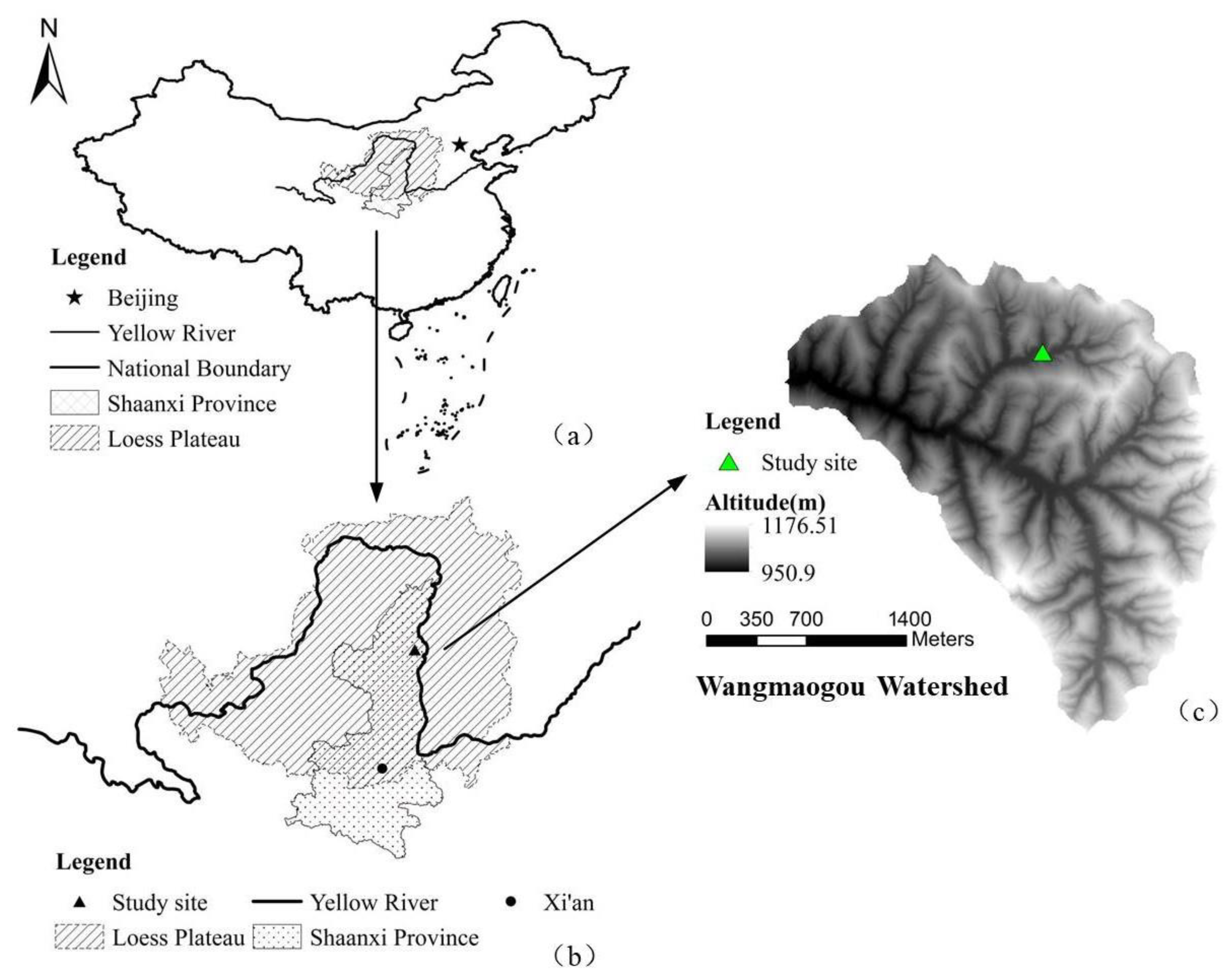
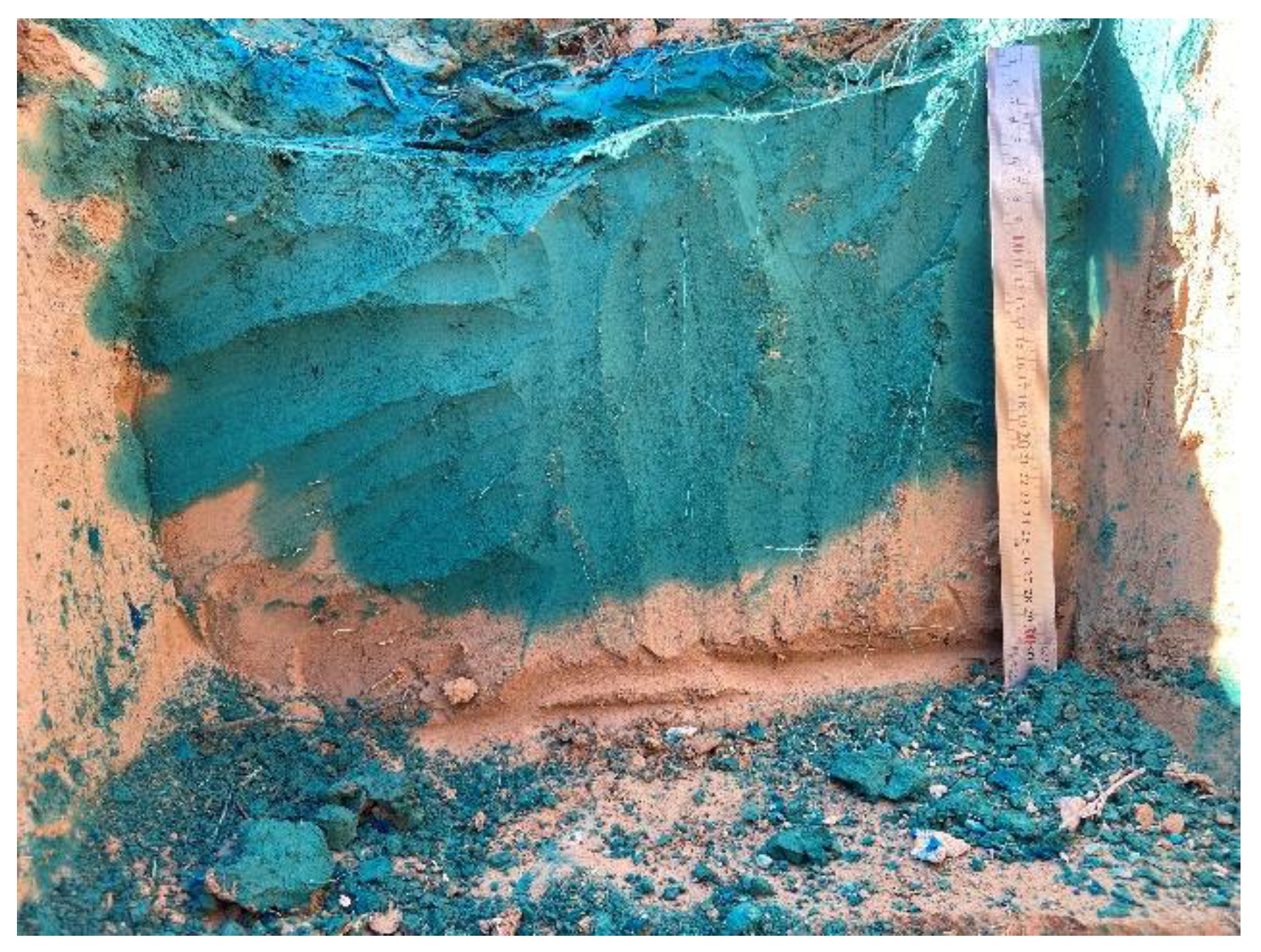
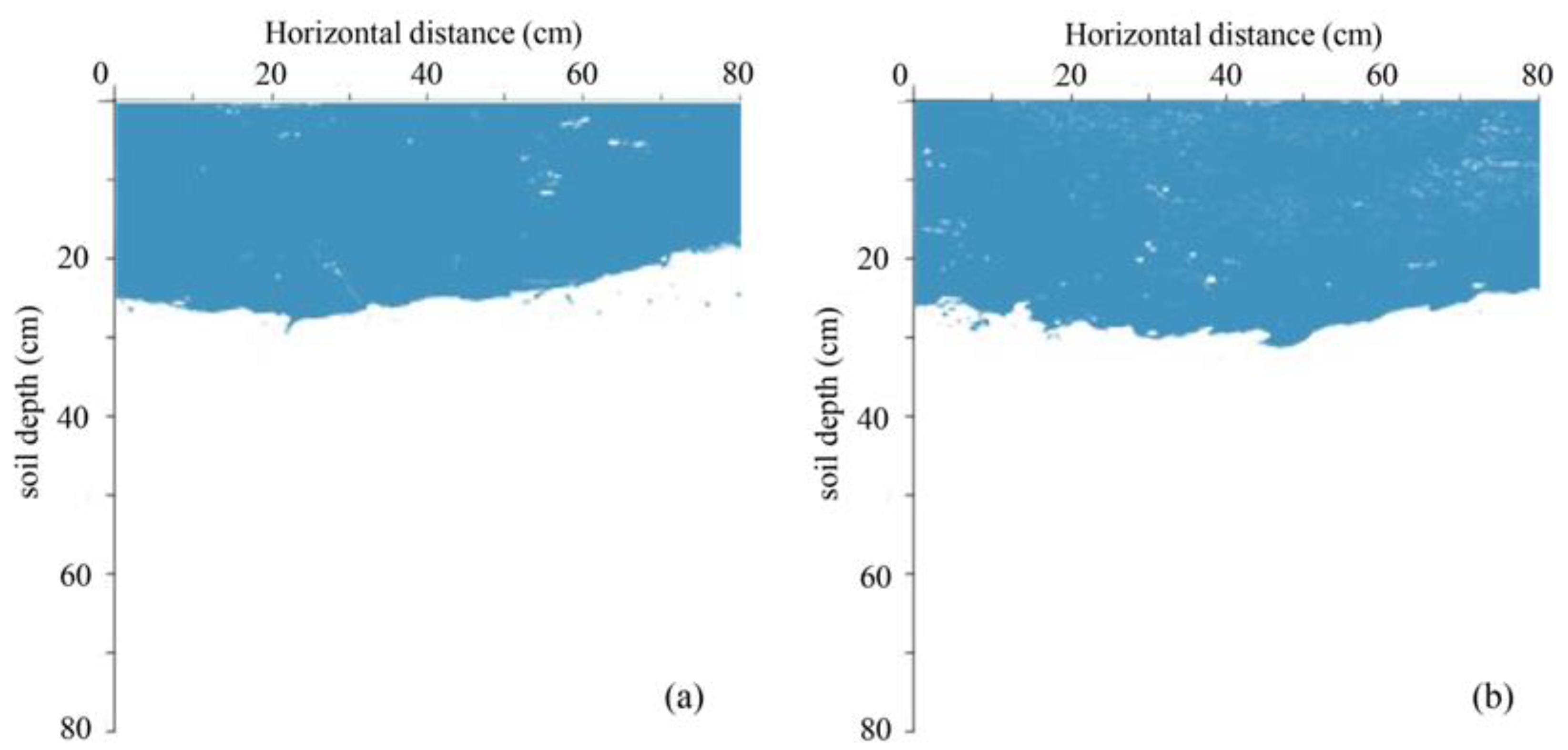
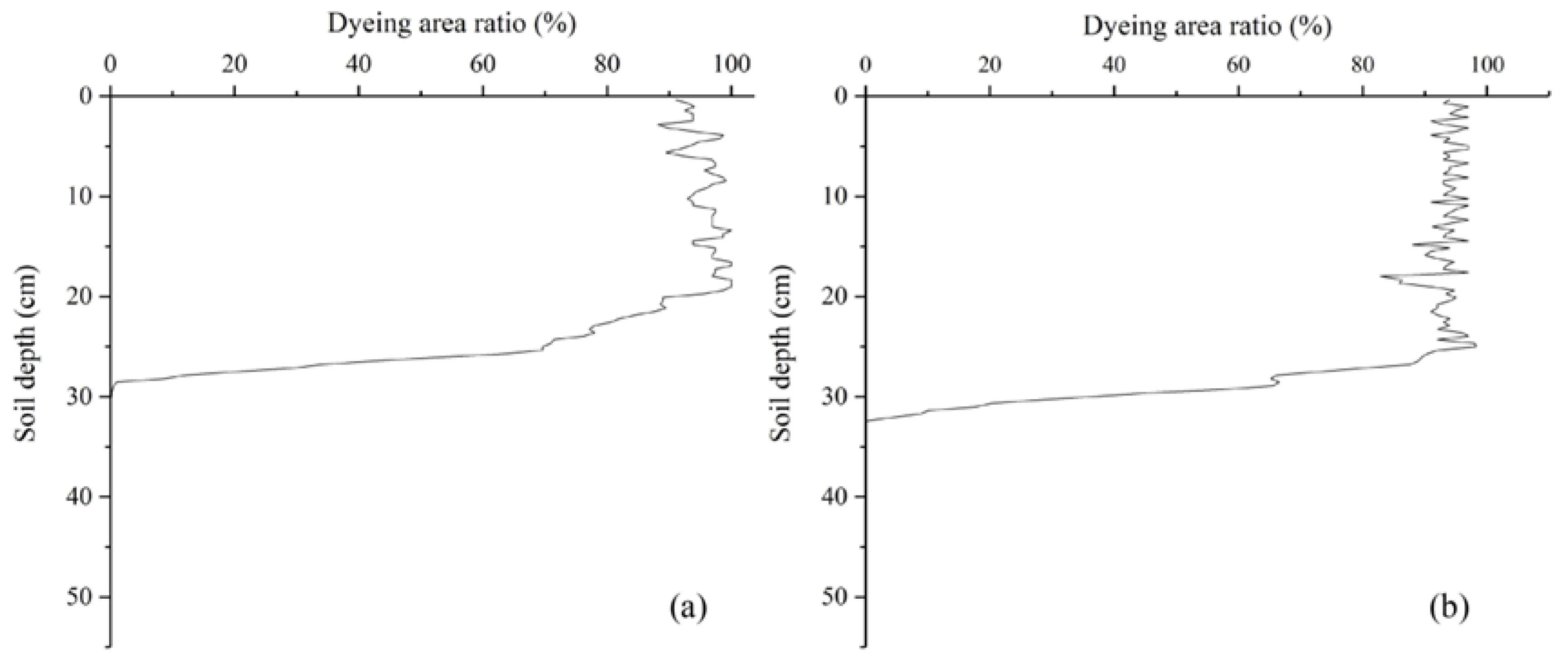
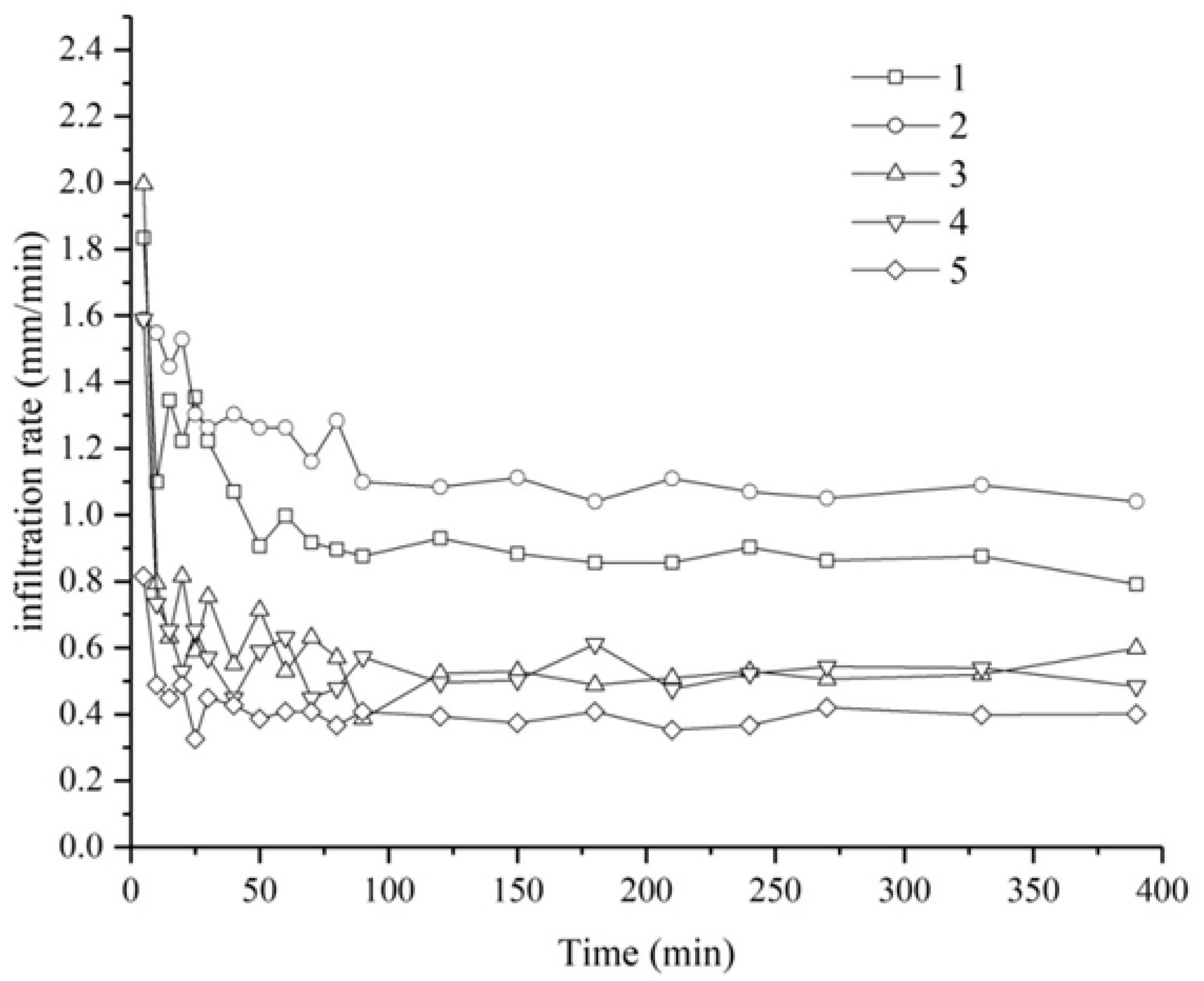
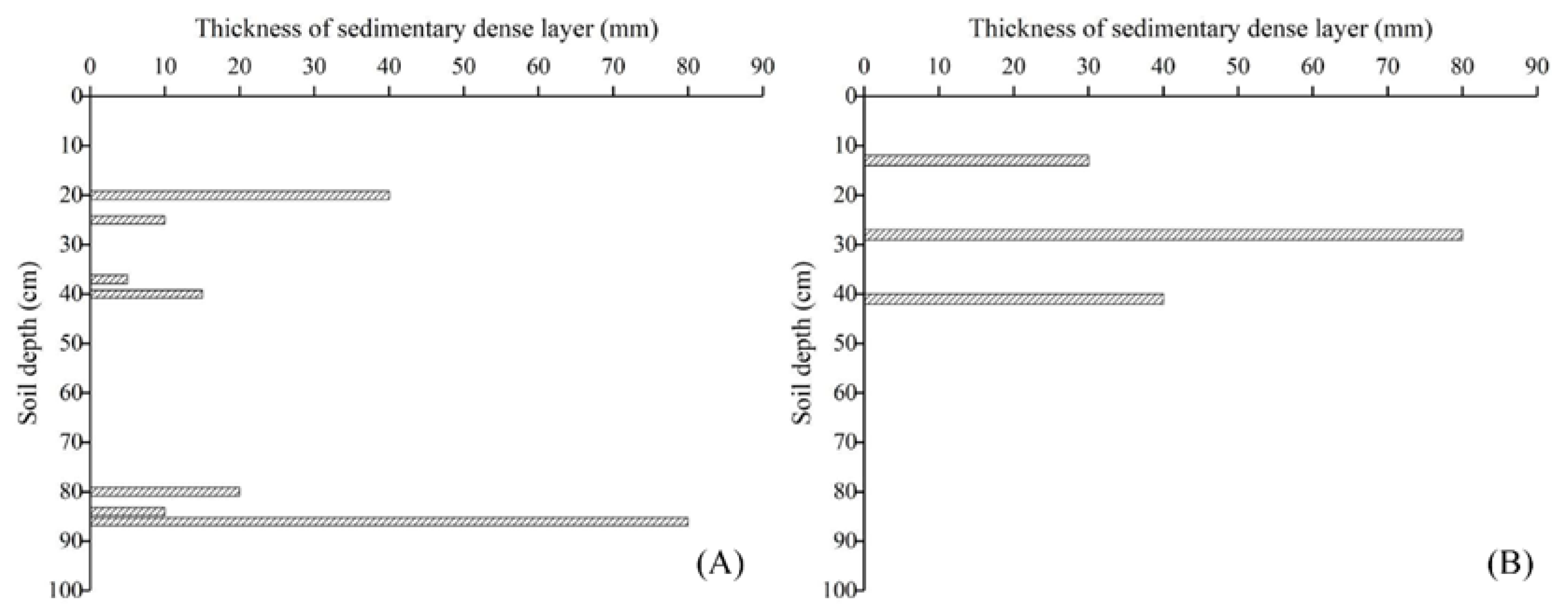
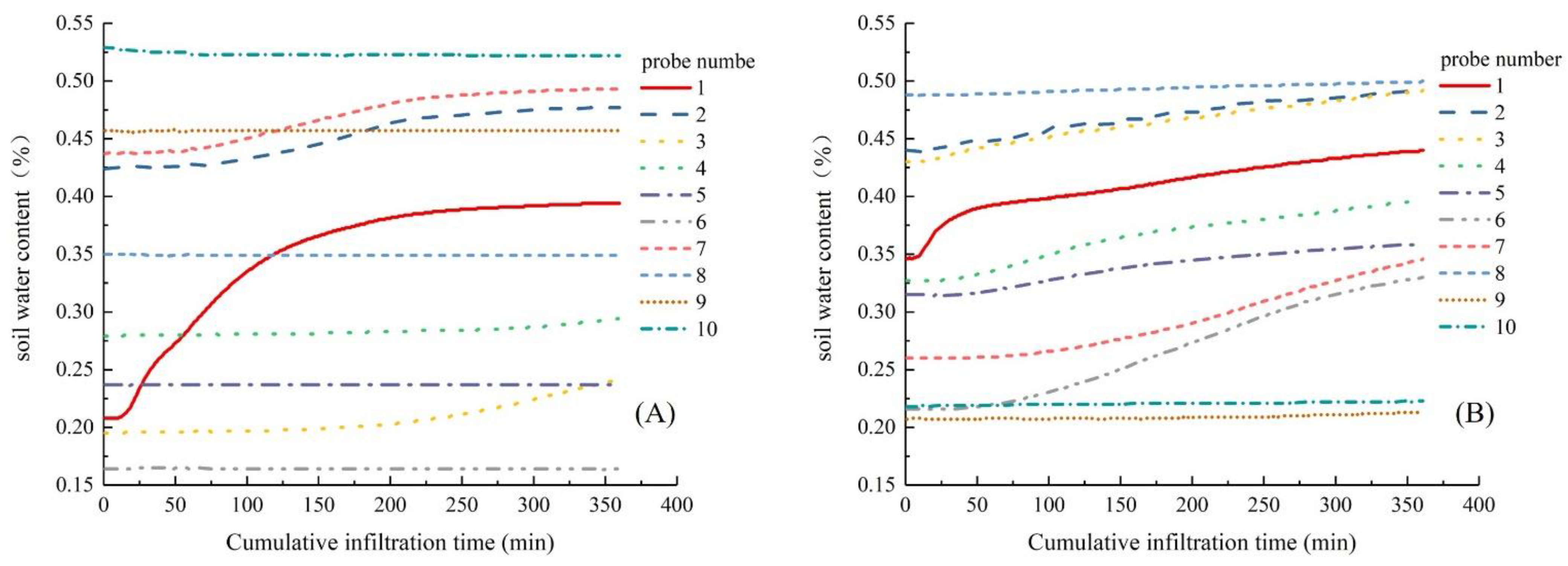
| Infiltration Characteristics | Test Times | ||||
|---|---|---|---|---|---|
| 1 | 2 | 3 | 4 | 5 | |
| 1.83 | 1.59 | 2.00 | 1.59 | 0.81 | |
| 0.87 | 1.08 | 0.51 | 0.53 | 0.39 | |
| 1.03 | 1.23 | 0.66 | 0.60 | 0.43 | |
| 9.43 | 11.71 | 6.17 | 5.38 | 3.91 | |
| A | B | ||||||
|---|---|---|---|---|---|---|---|
| Probe Number | Soil Depth (cm) | Soil Water Content (%) | Sedimentation Dense Layer | Probe Number | Soil Depth (cm) | Soil Water Content (%) | Sedimentation Dense Layer |
| 1 | 10 | 20.8 | No | 1 | 12 | 34.6 | No |
| 2 | 20 | 43.7 | Yes | 2 | 15 | 44 | Yes |
| 3 | 23 | 42.5 | Yes | 3 | 16 | 43 | Yes |
| 4 | 35 | 19.5 | No | 4 | 27 | 32.7 | No |
| 5 | 42 | 27.9 | No | 5 | 31 | 31.5 | Yes |
| 6 | 57 | 23.7 | No | 6 | 37 | 21.6 | No |
| 7 | 72 | 16.4 | No | 7 | 40 | 26 | No |
| 8 | 81 | 35 | Yes | 8 | 43 | 48.8 | yes |
| 9 | 86 | 45.7 | Yes | 9 | 46 | 20.7 | No |
| 10 | 91 | 52.7 | yes | 10 | 53 | 21.8 | No |
| Soil Index | Initial Infiltration Rate | Stable Infiltration Rate | Average Infiltration Rate | Silt | Sand | Clay | Initial Moisture Content | Bulk Density |
|---|---|---|---|---|---|---|---|---|
| Initial infiltration rate | 1 | |||||||
| Stable infiltration rate | 0.332 | 1 | ||||||
| Average infiltration rate | 0.440 | 0.989 ** | 1 | |||||
| Silt | −0.442 | 0.365 | 0.284 | 1 | ||||
| Sand | 0.456 | −0.351 | −0.268 | −0.999 ** | 1 | |||
| Clay | −0.421 | −0.261 | −0.318 | 0.172 | −0.214 | 1 | ||
| Initial moisture content | −0.628 * | 0.252 | 0.173 | 0.824 ** | −0.830 ** | 0.298 | 1 | |
| Bulk density | −0.084 | −0.286 | −0.259 | 0.011 | −0.026 | 0.348 | 0.074 | 1 |
| Test Times | Philip Model | Kostiakov Model | Horton Model | ||||||||||
|---|---|---|---|---|---|---|---|---|---|---|---|---|---|
| 1 | 4.55 | 0.70 | 0.83 | 0.10 | 2.10 | 0.17 | 0.77 | 0.11 | 0.04 | 0.87 | 1.83 | 0.79 | 0.11 |
| 2 | 3.24 | 0.99 | 0.85 | 0.07 | 1.93 | 0.11 | 0.89 | 0.05 | 0.02 | 1.06 | 1.59 | 0.90 | 0.05 |
| 3 | 5.42 | 0.26 | 0.67 | 0.18 | 2.49 | 0.34 | 0.57 | 0.21 | 0.10 | 0.53 | 2.00 | 0.72 | 0.17 |
| 4 | 3.86 | 0.32 | 0.62 | 0.14 | 1.65 | 0.25 | 0.48 | 0.17 | 0.10 | 0.52 | 1.59 | 0.73 | 0.12 |
| 5 | 1.6 | 0.31 | 0.64 | 0.06 | 0.75 | 0.14 | 0.45 | 0.07 | 0.09 | 0.39 | 0.81 | 0.73 | 0.05 |
Publisher’s Note: MDPI stays neutral with regard to jurisdictional claims in published maps and institutional affiliations. |
© 2022 by the authors. Licensee MDPI, Basel, Switzerland. This article is an open access article distributed under the terms and conditions of the Creative Commons Attribution (CC BY) license (https://creativecommons.org/licenses/by/4.0/).
Share and Cite
Wu, H.; Cheng, S.; Li, Z.; Ke, G.; Liu, H. Study on Soil Water Infiltration Process and Model Applicability of Check Dams. Water 2022, 14, 1814. https://doi.org/10.3390/w14111814
Wu H, Cheng S, Li Z, Ke G, Liu H. Study on Soil Water Infiltration Process and Model Applicability of Check Dams. Water. 2022; 14(11):1814. https://doi.org/10.3390/w14111814
Chicago/Turabian StyleWu, Heng, Shengdong Cheng, Zhanbin Li, Ganggang Ke, and Hangyu Liu. 2022. "Study on Soil Water Infiltration Process and Model Applicability of Check Dams" Water 14, no. 11: 1814. https://doi.org/10.3390/w14111814
APA StyleWu, H., Cheng, S., Li, Z., Ke, G., & Liu, H. (2022). Study on Soil Water Infiltration Process and Model Applicability of Check Dams. Water, 14(11), 1814. https://doi.org/10.3390/w14111814





